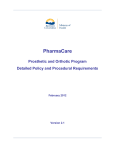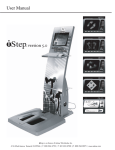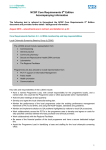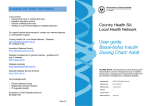Download Patient treatment report user guide
Transcript
Department of Veterans’ Affairs – Coordinated Veterans’ Care Program Patient Treatment Report User Guide 1 Patient Treatment Report User Guide Introduction About the Coordinated Veterans’ Care Program The Coordinated Veterans’ Care (CVC) Program is a new Department of Veterans’ Affairs (DVA) program to better manage and coordinate primary and community care for Gold Card holders who are most at risk of being admitted or readmitted to hospital. The CVC Program is focussed on providing additional support for veterans and war widow/ers with one or more chronic diseases or conditions, and who have been identified as having complex care needs. Through improved community based care, the program is intended to improve the health of participants by: • providing ongoing planned and coordinated care from their general practitioner (GP) and a nurse coordinator • educating and empowering participants to self manage their conditions • encouraging the most socially isolated to participate in community activities. To assist you in providing this support, the Patient Treatment Report has been developed to provide insight into your patient’s medical history and display potential opportunities for optimising patient care. Information in the PTR is compiled from DVA payment data, and has been used to identify potential gaps in patient care through the analysis of a patient’s medical and hospital admission history. Due to the timing of when claims are submitted for processing, we understand the information contained in the report may not be fully reflective of your current patient records. The PTR will provide you with information to: • identify opportunities for optimising patient care • maintain a comprehensive view of your patients’ care. Important information about the Patient Treatment Report Information in the PTR is compiled from payment data received by DVA. Payment data included in the report may not be as up to date as the information contained in your patient records. If the report does not list a test or treatment, it does not mean the test or treatment has not occurred. However, it does indicate that DVA has no record of the test or treatment being performed in the relevant period. The Patient Treatment Report The Patient Treatment Report (PTR) is a practice support tool that has been designed to provide evidence-based care for the management of chronic illness. The PTR does not, nor is it intended to, replace your professional clinical judgement as the patient’s treating general practitioner. 1 Reading the Patient Treatment Report Patient treatment report as at 31/07/2011 DR A SAMPLE 1 2 Chronic and other high risk conditions Claims data indicate that your patient has the following conditions: 3 CVC targeted chronic conditions 4 Other high risk conditions Patient: DVA Identifier: Age: Gender: Admission Risk Rank: JOHN SAMPLE XXXXXX 85 M 84 CAD Cancer Services received in the previous 12 months Where applicable, further information on recent hospitalisations and medications is included in the attached history. 5 Overnight Admissions Same Day Admissions 0 0 Specialist Visits GP Visits 1 6 27 VHC Hours CN Visits 0 0 AHP Visits Total Filled Medications 12 16 Patient history report for the past 6 months Overnight Admissions Discharge Diagnosis Code and Description Procedure Code and Description 7 None Allied Health Professionals (AHP) history for the past 3 months Type of Allied Health Professional Number of visits Last visit Diabetes Educators 1 23/08/2011 Exercise Physiologists 4 13/07/2011 Orthotists 2 02/07/2011 Osteopathic 1 01/07/2011 Medication history for the past 3 months Medication Strength BETAMETHASONE DIPROPIONATE Cream 500 micrograms (base) per g (0.05%), 15 g No. Filled 6 Date Last Filled 23/05/2011 CEPHALEXIN Capsule 500 mg 4 4/06/2011 v SODIUM Tablet 20 mg 7 19/05/2011 Clinical pathways opportunities 8 Clinical care and judgment is necessary in all matters, the following opportunities are intended as a guide only. Test/Treatment Received Condition Test / Treatment Date of service of most recent claim Yes CAD Lipid regulator medication 2/06/2011 Yes CAD Beta blocker medication 5/05/2011 Yes CAD Cholesterol test 17/01/2011 6 months of history included for medication opportunities and 12 months of history for test/treatment opportunities. This report has been sent by Bupa Health Dialog on behalf of the Coordinated Veterans’ Care Program, a Department of Veterans’ Affairs initiative. Please treat in accordance with Commonwealth and local privacy laws. www.dva.gov.au/cvc.htm 2 9 1 Patient’s DVA Gold Card number. 2 How likely a patient is to be readmitted to hospital in the next 12 months, against the overall DVA Gold Card population. The higher the rank, the more likely a patient is to be readmitted to hospital. The range of the admission risk rank is 0–100. 3 4 The relevant conditions targeted by the CVC Program – Coronary Artery Disease, COPD, Diabetes, CHF, Pneumonia will appear if applicable to the patient. Other selected high risk conditions may appear if applicable for the patient such as Hypertension, Depression, Cancer, Kidney disease, Osteoporosis, Lower back pain, Atrial Fibrillation, Hyperlipidemia, Asthma. 5 As paid by DVA. 6 May also include specialist visits, where a specialist is also a registered GP. 7 Primary treatment applied for each admission. In some cases, this may not appear as it may not have been received by DVA. 8 Clinical pathways opportunities represent the tests and treatment regimes for each patient’s chronic condition/s. It is for you, the GP, to decide if the treatments listed are appropriate for your patient/s and the table should be viewed as suggested opportunities only. 9 When the test or treatment was conducted or received for the most recent claim. 3 Patient Treatment Report User Guide Patient Overview Individual Patient Treatment Report This section provides an overview of all your patients enrolled in the CVC Program, and includes patient specific information including name, DVA identifier, gender and age. The date of the PTR is identified in the top left corner of the first page. This is the date up to which the claims history has been included. The admission risk rank identifies how likely a patient is to be readmitted to hospital within the next 12 months, against the overall DVA Gold Card population. The inpatient, outpatient and bed days fields give a snapshot of how many admissions, visits and number of days in hospital patients have had in the previous 12 months (excluding same day visits). If your patient has one or more of the five conditions targeted by the CVC Program, clinical pathways opportunities will be indicated by the number of tests and treatment regimes recommended for each patient’s chronic condition/s. Patient Condition Overview This section highlights which of the five chronic conditions targeted by the CVC Program each of your patients may currently have. This section takes into account all history for four of the targeted conditions (Diabetes, Coronary Artery Disease, Congestive Heart Failure, Chronic Obstructive Pulmonary Disease) and the previous 36 months for the remaining targeted condition – Pneumonia. The ICD-10 AM diagnosis and procedure codes at any position (not restricted to primary diagnosis or procedure only), MBS, prostheses and a few ancillary item numbers were used from the claims to identify the conditions that the patients have. Pharmacy claims were not included for the condition identification. 4 Each patient is identified in the top right corner with their name, DVA identifier, age and gender. Admission Risk Rank Bupa Health Dialog, on behalf of DVA, has used DVA payments data to develop and implement a DVA specific predictive admission/re-admission risk model. The model output includes an admission risk rank that identifies how likely a patient is to be readmitted to hospital within the next 12 months, against the overall DVA Gold Card population. The range of the admission risk rank is 0 – 100. The higher the rank, the higher is the risk of the patient being admitted to hospital compared to the overall Gold Card population. Factors which are included in the formulation of the admission risk rank include, but are not limited to: • chronic conditions • medical and hospital costs • number of overnight admissions • length of time since last admission • length of time between the last two admissions • medical procedures. Chronic and other high risk conditions This section highlights which of the five chronic conditions are targeted by the CVC Program: • Diabetes • Coronary Artery Disease • Congestive Heart Failure • Chronic Obstructive Pulmonary Disease • Pneumonia, and other selected high risk conditions that your patients may have. If your patients don’t have any of these conditions, this section will be left blank. Services received in the previous 12 months This section outlines the types of services and interactions the patient has received in the previous 12 months. Where applicable, further information on recent hospitalisations and medications has been provided in a separate table. GP visits may include patient visits to their GP/s, and/or specialist/s where the specialist is also registered as a GP. Patient history report for the past 6 months Other selected high risk conditions include Hypertension, Depression, Cancer, Kidney disease, Osteoporosis, Lower back pain, Atrial Fibrillation, Hyperlipidemia and Asthma. This table outlines specific details for the patient’s overnight hospital admissions over the past 6 months, prior to the date of the report. Patients who have been identified with Diabetes, Congestive Heart Failure, Coronary Artery Disease and Chronic Obstructive Pulmonary Disease at any stage will always be highlighted in this section, regardless of their current condition status. Overnight admissions – refers to the date of the admission. Discharge date refers to when the patient left the hospital following treatment. For all other conditions listed, including Pneumonia, patients who have been diagnosed in the last 36 months only will be identified. Procedure code and description – outlines the primary treatment which was applied for each admission. In some cases, this information may not appear as it may not have been received by DVA. Diagnosis code and description – refers to the primary diagnosis made when the patient was admitted for each event. 5 Patient Treatment Report User Guide Allied Health Professionals (AHP) history for the past 3 months This highlights the number of visits to AHPs in the last 3 months along with the date of most recent service. Each AHP type will appear on a separate line. The following AHPs will be included: • Chiropractic • Dental • Diabetes Educators • Dietetics • Exercise Physiologists • Occupational Therapy • Optical • Orthotists • Osteopathic • Physiotherapy Clinical Pathways Opportunities Clinical pathways opportunities represent the tests and treatment regimes for each patient’s chronic condition/s. It is for you, the GP, to decide if the treatments listed are appropriate for your patient/s and the table should be viewed as suggested opportunities only. In the development of the PTR, DVA has referenced guidelines established by the relevant national bodies in Australia to identify certain elements of clinical care that might be identified by a DVA payment. Where no payments of these types have been made by the DVA, it is for you, the GP to decide if the treatments listed are appropriate for your patient/s and the table should be viewed as suggested opportunities only. The guidelines used are listed below: • Podiatry Coronary Artery Disease • Psychology National Heart Foundation and the Cardiac Society of Australia and New Zealand. • Social Work • Speech Pathology Medication history for the past 3 months The medication table describes the name of the medication (drug name), strength and how many times the medication has been filled in the last 3 months, as available to DVA. The date provided is the ‘Date Last Filled’ and identifies the most recent fill date for each medication-strength combination. If the strength of a given medication changes, this will appear as a new line. 6 Reducing the risk of heart disease 2007 (updated 2008). Retrieved October 2011, from http:// www.heartfoundation.org.au/ SiteCollectionDocuments/Reduce-risk-inheart-disease-guideline.pdf Congestive Heart Failure Chronic Obstructive Pulmonary Disease National Heart Foundation of Australia and the Cardiac Society of Australia and New Zealand (Chronic Heart Failure Guidelines Expert Writing Panel) (2011, October). The Australian Lung Foundation and the Thoracic Society of Australia and New Zealand. Guidelines for the prevention, detection and management of Chronic Heart Failure in Australia. Retrieved October 2011, from http:// www.heartfoundation.org.au/ SiteCollectionDocuments/Chronic_Heart_ Failure_Guidelines_2011.pdf Diabetes Royal Australian College of General Practitioners and Diabetes Australia. Diabetes management in general practice Seventeenth edition 2011/12 Guidelines for Type 2 diabetes. Retrieved October 2011, from http://www. racgp.org.au/Content/NavigationMenu/ ClinicalResources/RACGPGuidelines/Diabet esmanagement/201107diabetesmanagemen tingeneralpractice.pdf Australian and New Zealand Guidelines for the management of chronic obstructive pulmonary disease 2011. Retrieved October 2011, from http://www.copdx.org.au/executive-summary According to the claims paid by the DVA to date, the test/treatment column indicates if the patient has received (yes) or has not received (no) the tests and/or treatments as outlined in the guidelines for each condition. Note: some tests and/or treatments may not be included if claims have not been paid by DVA. This is limited to the following conditions: • Diabetes • Congestive Heart Failure • Coronary Artery Disease • Chronic Obstructive Pulmonary Disease. The condition field outlines the specific disease that the tests and treatments are relevant for. The most recent claim date represents when the test or treatment was last conducted or received. 7 Frequently Asked Questions Does the Patient Treatment Report include all of my patients? The Patient Treatment Report (PTR) only includes information on those patients that you have currently enrolled on the CVC Program. Should you enrol any new patients on the program, you will receive subsequent PTRs for them in the quarter following their enrolment. Why has the Patient Treatment Report been sent to me? You have received the PTR because you have a patient or patients enrolled on the CVC Program. The PTR is a practice support tool for GPs. Who produces the Patient Treatment Report? The PTR is produced by Bupa Health Dialog on behalf of the Coordinated Veterans’ Care Program, a Department of Veterans’ Affairs initiative. Will I always receive hard copies of the report? Each time you enrol a new veteran on the CVC Program, you will receive the first quarterly report in hard copy format. Future reports are planned for online delivery. How is the data in the report sourced? The PTR is sourced from claims data, as held by DVA. • Hospital – includes public and private hospitals • Medical – includes claims from GP visits, specialist visits, and other medical services received during a hospital admission 8 • Prostheses – includes claims associated with prosthetics, human tissue and associated materials used during a hospital admission • Ancillary – includes claims associated with allied health professionals, dental, optical and associated services • DVA specific – including services provided specifically for veterans, including community nursing services and Veterans’ Home Care services • Pharmacy – including medications the patient is currently on. Can I give the report to my patients? The PTR is intended to be a tool for you, as the GP, to use to support you in delivering care to patients with chronic illness, and as such contains sensitive patient information and is confidential. The information contained in the PTR may only be used or disclosed for the purposes of the CVC Program. The PTR must be handled confidentially and strictly in accordance with the Privacy Act 1988 (Cth), and any health records legislation that may be applicable in your State or Territory. The PTR remains the property of the Department of Veterans’ Affairs. Who can I contact for more information and give feedback? For more information and give feedback on the Patient Treatment Report please contact the CVC Provider Helpline: • Call 1300 550 597 • Email: [email protected] Where can I find more information? Call 1300 550 597 Email [email protected] Visit www.dva.gov.au/cvc.htm Glossary Admission risk rank – how likely a patient is to be readmitted to hospital within the next 12 months, against the overall DVA Gold Card population on a scale 0–100. AHP – Allied Health Professionals Australian Medical Guidelines – reference materials used to identify clinical pathways opportunities for patients with chronic conditions CAD – Coronary Artery Disease CHF – Congestive Heart Failure Chronic Condition identification – this is established through the use of diagnosis, procedure and MBS item numbers to identify which chronic condition/s a patient has Claim date – when the test or treatment was last conducted or received by the patient Clinical Pathways Opportunities – Clinical pathways opportunities represent the tests and treatment regimes recommended for each patient’s chronic condition/s. It is for you, the GP, to decide if the treatments listed are appropriate for your patient/s and should be viewed as suggested opportunities only CN – Community Nurse COPD – Chronic Obstructive Pulmonary Disease CVC Program – Coordinated Veterans’ Care Program CVC targeted chronic conditions – the five conditions targeted by the CVC Program, being Diabetes, Coronary Artery Disease, Congestive Heart Failure, Chronic Obstructive Pulmonary Disease and Pneumonia Discharge – the date a patient left the hospital DVA – Department of Veterans’ Affairs DVA Identifier – the number which appears on a patient’s Gold Card and identifies them to DVA Gold Card – Gold Repatriation Health Card that entitles the holder to DVA funding for all health services according to clinical need. Hospital utilisation: • Inpatient same day admissions – an admission and discharge date were on the same day • Inpatient overnight admissions – where admission and discharge dates are at least one day apart. MBS – Medicare Benefits Schedule Outpatient utilisation: • GP Visits – the number of visits a patient has had with any GP, including multiple GPs • Specialist visits – the number of visits to any specialist • Community Nurse visits – the number of visits to or from a community nurse • Total VHC hours – number of hours received under Veterans’ Home Care services Overnight admissions – admissions where a patient has been in hospital overnight PTR – Patient Treatment Report, a practice support tool to provide evidence-based care for chronic illness Specialist – specialists may be referred to in the report where a specialist is also registered as a GP Total Bed days – number of days a patient has been in the hospital VHC – Veterans’ Home Care 9 For more information: Call 1300 550 597 Email [email protected] Visit www.dva.gov.au/cvc.htm The Coordinated Veterans’ Care Program is a Department of Veterans’ Affairs initiative, supported by primary service provider, Bupa Health Dialog. A DVA_PTR_V1.2_120131
























